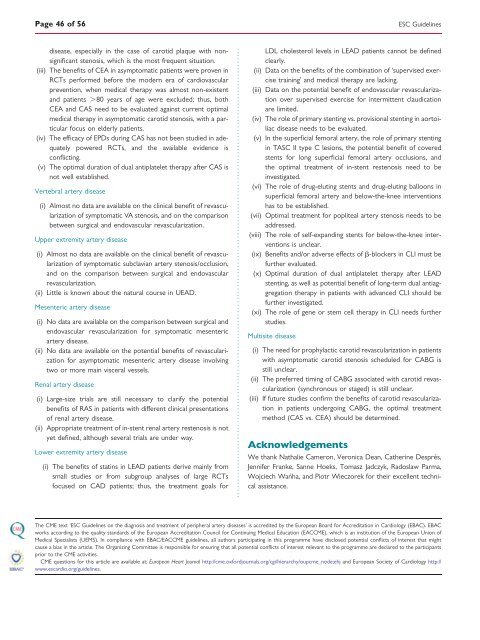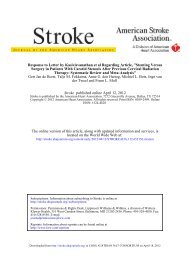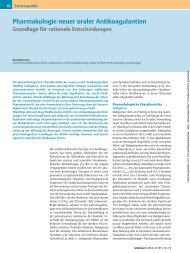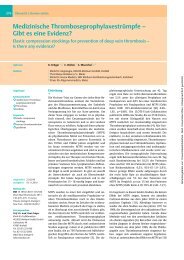Page 46 <strong>of</strong> 56 disease, especially in <strong>the</strong> case <strong>of</strong> carotid plaque with n<strong>on</strong>significant stenosis, which is <strong>the</strong> most frequent situati<strong>on</strong>. (iii) The benefits <strong>of</strong> CEA in asymptomatic patients were proven in RCTs performed before <strong>the</strong> modern era <strong>of</strong> cardiovascular preventi<strong>on</strong>, when medical <strong>the</strong>rapy was almost n<strong>on</strong>-existent <strong>and</strong> patients .80 years <strong>of</strong> age were excluded; thus, both CEA <strong>and</strong> CAS need to be evaluated against current optimal medical <strong>the</strong>rapy in asymptomatic carotid stenosis, with a particular focus <strong>on</strong> elderly patients. (iv) The efficacy <strong>of</strong> EPDs during CAS has not been studied in adequately powered RCTs, <strong>and</strong> <strong>the</strong> available evidence is c<strong>on</strong>flicting. (v) The optimal durati<strong>on</strong> <strong>of</strong> dual antiplatelet <strong>the</strong>rapy after CAS is not well established. Vertebral <strong>artery</strong> disease (i) Almost no data are available <strong>on</strong> <strong>the</strong> clinical benefit <strong>of</strong> revascularizati<strong>on</strong> <strong>of</strong> symptomatic VA stenosis, <strong>and</strong> <strong>on</strong> <strong>the</strong> comparis<strong>on</strong> between surgical <strong>and</strong> endovascular revascularizati<strong>on</strong>. Upper extremity <strong>artery</strong> disease (i) Almost no data are available <strong>on</strong> <strong>the</strong> clinical benefit <strong>of</strong> revascularizati<strong>on</strong> <strong>of</strong> symptomatic subclavian <strong>artery</strong> stenosis/occlusi<strong>on</strong>, <strong>and</strong> <strong>on</strong> <strong>the</strong> comparis<strong>on</strong> between surgical <strong>and</strong> endovascular revascularizati<strong>on</strong>. (ii) Little is known about <strong>the</strong> natural course in UEAD. Mesenteric <strong>artery</strong> disease (i) No data are available <strong>on</strong> <strong>the</strong> comparis<strong>on</strong> between surgical <strong>and</strong> endovascular revascularizati<strong>on</strong> for symptomatic mesenteric <strong>artery</strong> disease. (ii) No data are available <strong>on</strong> <strong>the</strong> potential benefits <strong>of</strong> revascularizati<strong>on</strong> for asymptomatic mesenteric <strong>artery</strong> disease involving two or more main visceral vessels. Renal <strong>artery</strong> disease (i) Large-size trials are still necessary to clarify <strong>the</strong> potential benefits <strong>of</strong> RAS in patients with different clinical presentati<strong>on</strong>s <strong>of</strong> renal <strong>artery</strong> disease. (ii) Appropriate <strong>treatment</strong> <strong>of</strong> in-stent renal <strong>artery</strong> restenosis is not yet defined, although several trials are under way. Lower extremity <strong>artery</strong> disease (i) The benefits <strong>of</strong> statins in LEAD patients derive mainly from small studies or from subgroup analyses <strong>of</strong> large RCTs focused <strong>on</strong> CAD patients; thus, <strong>the</strong> <strong>treatment</strong> goals for LDL cholesterol levels in LEAD patients cannot be defined clearly. (ii) Data <strong>on</strong> <strong>the</strong> benefits <strong>of</strong> <strong>the</strong> combinati<strong>on</strong> <strong>of</strong> ‘supervised exercise training’ <strong>and</strong> medical <strong>the</strong>rapy are lacking. (iii) Data <strong>on</strong> <strong>the</strong> potential benefit <strong>of</strong> endovascular revascularizati<strong>on</strong> over supervised exercise for intermittent claudicati<strong>on</strong> are limited. (iv) The role <strong>of</strong> primary stenting vs. provisi<strong>on</strong>al stenting in aortoiliac disease needs to be evaluated. (v) In <strong>the</strong> superficial femoral <strong>artery</strong>, <strong>the</strong> role <strong>of</strong> primary stenting in TASC II type C lesi<strong>on</strong>s, <strong>the</strong> potential benefit <strong>of</strong> covered stents for l<strong>on</strong>g superficial femoral <strong>artery</strong> occlusi<strong>on</strong>s, <strong>and</strong> <strong>the</strong> optimal <strong>treatment</strong> <strong>of</strong> in-stent restenosis need to be investigated. (vi) The role <strong>of</strong> drug-eluting stents <strong>and</strong> drug-eluting ballo<strong>on</strong>s in superficial femoral <strong>artery</strong> <strong>and</strong> below-<strong>the</strong>-knee interventi<strong>on</strong>s has to be established. (vii) Optimal <strong>treatment</strong> for popliteal <strong>artery</strong> stenosis needs to be addressed. (viii) The role <strong>of</strong> self-exp<strong>and</strong>ing stents for below-<strong>the</strong>-knee interventi<strong>on</strong>s is unclear. (ix) Benefits <strong>and</strong>/or adverse effects <strong>of</strong> b-blockers in CLI must be fur<strong>the</strong>r evaluated. (x) Optimal durati<strong>on</strong> <strong>of</strong> dual antiplatelet <strong>the</strong>rapy after LEAD stenting, as well as potential benefit <strong>of</strong> l<strong>on</strong>g-term dual antiaggregati<strong>on</strong> <strong>the</strong>rapy in patients with advanced CLI should be fur<strong>the</strong>r investigated. (xi) The role <strong>of</strong> gene or stem cell <strong>the</strong>rapy in CLI needs fur<strong>the</strong>r studies. Multisite disease (i) The need for prophylactic carotid revascularizati<strong>on</strong> in patients with asymptomatic carotid stenosis scheduled for CABG is still unclear. (ii) The preferred timing <strong>of</strong> CABG associated with carotid revascularizati<strong>on</strong> (synchr<strong>on</strong>ous or staged) is still unclear. (iii) If future studies c<strong>on</strong>firm <strong>the</strong> benefits <strong>of</strong> carotid revascularizati<strong>on</strong> in patients undergoing CABG, <strong>the</strong> optimal <strong>treatment</strong> method (CAS vs. CEA) should be determined. Acknowledgements <str<strong>on</strong>g>ESC</str<strong>on</strong>g> <str<strong>on</strong>g>Guidelines</str<strong>on</strong>g> We thank Nathalie Camer<strong>on</strong>, Ver<strong>on</strong>ica Dean, Ca<strong>the</strong>rine Després, Jennifer Franke, Sanne Hoeks, Tomasz Jadczyk, Radoslaw Parma, Wojciech Wańha, <strong>and</strong> Piotr Wieczorek for <strong>the</strong>ir excellent technical assistance. The CME text ‘<str<strong>on</strong>g>ESC</str<strong>on</strong>g> <str<strong>on</strong>g>Guidelines</str<strong>on</strong>g> <strong>on</strong> <strong>the</strong> <strong>diagnosis</strong> <strong>and</strong> <strong>treatment</strong> <strong>of</strong> <strong>peripheral</strong> <strong>artery</strong> diseases’ is accredited by <strong>the</strong> European Board for Accreditati<strong>on</strong> in Cardiology (EBAC). EBAC works according to <strong>the</strong> quality st<strong>and</strong>ards <strong>of</strong> <strong>the</strong> European Accreditati<strong>on</strong> Council for C<strong>on</strong>tinuing Medical Educati<strong>on</strong> (EACCME), which is an instituti<strong>on</strong> <strong>of</strong> <strong>the</strong> European Uni<strong>on</strong> <strong>of</strong> Medical Specialists (UEMS). In compliance with EBAC/EACCME guidelines, all authors participating in this programme have disclosed potential c<strong>on</strong>flicts <strong>of</strong> interest that might cause a bias in <strong>the</strong> article. The Organizing Committee is resp<strong>on</strong>sible for ensuring that all potential c<strong>on</strong>flicts <strong>of</strong> interest relevant to <strong>the</strong> programme are declared to <strong>the</strong> participants prior to <strong>the</strong> CME activities. CME questi<strong>on</strong>s for this article are available at: European Heart Journal http://cme.oxfordjournals.org/cgi/hierarchy/oupcme_node;ehj <strong>and</strong> European Society <strong>of</strong> Cardiology http:// www.escardio.org/guidelines.
<str<strong>on</strong>g>ESC</str<strong>on</strong>g> <str<strong>on</strong>g>Guidelines</str<strong>on</strong>g> Page 47 <strong>of</strong> 56 References 1. Steg PG, Bhatt DL, Wils<strong>on</strong> PW, D’Agostino R Sr, Ohman EM, Ro<strong>the</strong>r J, Liau CS, Hirsch AT, Mas JL, Ikeda Y, Pencina MJ, Goto S. One-year cardiovascular event rates in outpatients with a<strong>the</strong>rothrombosis. JAMA 2007;297:1197–1206. 2. Criqui MH, Langer RD, Fr<strong>on</strong>ek A, Feigels<strong>on</strong> HS, Klauber MR, McCann TJ, Browner D. Mortality over a period <strong>of</strong> 10 years in patients with <strong>peripheral</strong> arterial disease. N Engl J Med 1992;326:381–386. 3. Sigvant B, Wiberg-Hedman K, Bergqvist D, Rol<strong>and</strong>ss<strong>on</strong> O, Anderss<strong>on</strong> B, Perss<strong>on</strong> E, Wahlberg E. A populati<strong>on</strong>-based study <strong>of</strong> <strong>peripheral</strong> arterial disease prevalence with special focus <strong>on</strong> critical limb ischemia <strong>and</strong> sex differences. J Vasc Surg 2007;45:1185–1191. 4. Kroger K, Stang A, K<strong>on</strong>dratieva J, Moebus S, Beck E, Schmermund A, Mohlenkamp S, Dragano N, Siegrist J, Jockel KH, Erbel R. Prevalence <strong>of</strong> <strong>peripheral</strong> arterial disease—results <strong>of</strong> <strong>the</strong> Heinz Nixdorf recall study. Eur J Epidemiol 2006;21:279–285. 5. Kannel WB, McGee DL. Update <strong>on</strong> some epidemiologic features <strong>of</strong> intermittent claudicati<strong>on</strong>: <strong>the</strong> Framingham Study. J Am Geriatr Soc 1985;33:13–18. 6. Norgren L, Hiatt WR, Dorm<strong>and</strong>y JA, Nehler MR, Harris KA, Fowkes FGR. Inter- Society C<strong>on</strong>sensus for <strong>the</strong> Management <strong>of</strong> Peripheral Arterial Disease (TASC II). J Vasc Surg 2007;45:S5–S67. 7. Ingolfss<strong>on</strong> IO, Sigurdss<strong>on</strong> G, Sigvaldas<strong>on</strong> H, Thorgeirss<strong>on</strong> G, Sigfuss<strong>on</strong> N. A marked decline in <strong>the</strong> prevalence <strong>and</strong> incidence <strong>of</strong> intermittent claudicati<strong>on</strong> in Icel<strong>and</strong>ic men 1968–1986: a str<strong>on</strong>g relati<strong>on</strong>ship to smoking <strong>and</strong> serum cholesterol—<strong>the</strong> Reykjavik Study. J Clin Epidemiol 1994;47:1237–1243. 8. Murabito JM, Evans JC, D’Agostino RB Sr, Wils<strong>on</strong> PW, Kannel WB. Temporal trends in <strong>the</strong> incidence <strong>of</strong> intermittent claudicati<strong>on</strong> from 1950 to 1999. Am J Epidemiol 2005;162:430–437. 9. Bots ML, Breslau PJ, Briet E, de Bruyn AM, van Vliet HH, van den Ouwel<strong>and</strong> FA, de J<strong>on</strong>g PT, H<strong>of</strong>man A, Grobbee DE. Cardiovascular determinants <strong>of</strong> carotid <strong>artery</strong> disease. The Rotterdam Elderly Study. Hypertensi<strong>on</strong> 1992;19:717–720. 10. Mathiesen EB, Joakimsen O, B<strong>on</strong>aa KH. Prevalence <strong>of</strong> <strong>and</strong> risk factors associated with carotid <strong>artery</strong> stenosis: <strong>the</strong> Tromso Study. Cerebrovasc Dis 2001;12:44–51. 11. O’Leary DH, Polak JF, Kr<strong>on</strong>mal RA, Kittner SJ, B<strong>on</strong>d MG, Wolfs<strong>on</strong> SK Jr, Bommer W, Price TR, Gardin JM, Savage PJ. Distributi<strong>on</strong> <strong>and</strong> correlates <strong>of</strong> s<strong>on</strong>ographically detected carotid <strong>artery</strong> disease in <strong>the</strong> Cardiovascular Health Study. The CHS Collaborative Research Group. Stroke 1992;23:1752–1760. 12. Hansen KJ, Edwards MS, Craven TE, Cherr GS, Jacks<strong>on</strong> SA, Appel RG, Burke GL, Dean RH. Prevalence <strong>of</strong> renovascular disease in <strong>the</strong> elderly: a populati<strong>on</strong>-based study. J Vasc Surg 2002;36:443–451. 13. de Mast Q, Beutler JJ. The prevalence <strong>of</strong> a<strong>the</strong>rosclerotic renal <strong>artery</strong> stenosis in risk groups: a systematic literature review. J Hypertens 2009;27:1333–1340. 14. Valentine RJ, Martin JD, Myers SI, Rossi MB, Clagett GP. Asymptomatic celiac <strong>and</strong> superior mesenteric <strong>artery</strong> stenoses are more prevalent am<strong>on</strong>g patients with unsuspected renal <strong>artery</strong> stenoses. J Vasc Surg 1991;14:195–199. 15. Shadman R, Criqui MH, Bundens WP, Fr<strong>on</strong>ek A, Denenberg JO, Gamst AC, McDermott MM. Subclavian <strong>artery</strong> stenosis: prevalence, risk factors, <strong>and</strong> associati<strong>on</strong> with cardiovascular diseases. J Am Coll Cardiol 2004;44:618–623. 16. Fowkes FG, Housley E, Riemersma RA, Macintyre CC, Cawood EH, Prescott RJ, Ruckley CV. Smoking, lipids, glucose intolerance, <strong>and</strong> blood pressure as risk factors for <strong>peripheral</strong> a<strong>the</strong>rosclerosis compared with ischemic heart disease in <strong>the</strong> Edinburgh Artery Study. Am J Epidemiol 1992;135:331–340. 17. Criqui MH. Peripheral arterial disease—epidemiological aspects. Vasc Med 2001; 6:3–7. 18. St<strong>of</strong>fers HE, Rinkens PE, Kester AD, Kaiser V, Knottnerus JA. The prevalence <strong>of</strong> asymptomatic <strong>and</strong> unrecognized <strong>peripheral</strong> arterial occlusive disease. Int J Epidemiol 1996;25:282–290. 19. Meijer WT, Hoes AW, Rutgers D, Bots ML, H<strong>of</strong>man A, Grobbee DE. Peripheral arterial disease in <strong>the</strong> elderly: <strong>the</strong> Rotterdam Study. Arterioscler Thromb Vasc Biol 1998;18:185–192. 20. Ridker PM, Stampfer MJ, Rifai N. Novel risk factors for systemic a<strong>the</strong>rosclerosis: a comparis<strong>on</strong> <strong>of</strong> C-reactive protein, fibrinogen, homocysteine, lipoprotein(a), <strong>and</strong> st<strong>and</strong>ard cholesterol screening as predictors <strong>of</strong> <strong>peripheral</strong> arterial disease. JAMA 2001;285:2481–2485. 21. Chrysochou C, Kalra PA. Epidemiology <strong>and</strong> natural history <strong>of</strong> a<strong>the</strong>rosclerotic renovascular disease. Prog Cardiovasc Dis 2009;52:184–195. 22. English JA, Carell ES, Guidera SA, Tripp HF. Angiographic prevalence <strong>and</strong> clinical predictors <strong>of</strong> left subclavian stenosis in patients undergoing diagnostic cardiac ca<strong>the</strong>terizati<strong>on</strong>. Ca<strong>the</strong>ter Cardiovasc Interv 2001;54:8–11. 23. Pickett CA, Jacks<strong>on</strong> JL, Hemann BA, Atwood JE. Carotid bruits as a prognostic indicator <strong>of</strong> cardiovascular death <strong>and</strong> myocardial infarcti<strong>on</strong>: a meta-analysis. Lancet 2008;371:1587–1594. 24. Graham I, Atar D, Borch-Johnsen K, Boysen G, Burell G, Cifkova R, Dall<strong>on</strong>geville J, De Backer G, Ebrahim S, Gjelsvik B, Herrmann-Lingen C, Hoes A, Humphries S, Knapt<strong>on</strong> M, Perk J, Priori SG, Pyorala K, Reiner Z, Ruilope L, Sans-Menendez S, Scholte op Reimer W, Weissberg P, Wood D, Yarnell J, Zamorano JL, Walma E, Fitzgerald T, Co<strong>on</strong>ey MT, Dudina A. European guidelines <strong>on</strong> cardiovascular disease preventi<strong>on</strong> in clinical practice: executive summary: Fourth Joint Task Force <strong>of</strong> <strong>the</strong> European Society <strong>of</strong> Cardiology <strong>and</strong> O<strong>the</strong>r Societies <strong>on</strong> Cardiovascular Disease Preventi<strong>on</strong> in Clinical Practice (C<strong>on</strong>stituted by representatives <strong>of</strong> nine societies <strong>and</strong> by invited experts). Eur Heart J 2007;28:2375–2414. 25. Reiner Z, Catapano A, De Backer G, Graham I, Taskinen MR, Wiklund O, Agewall S, Alegria E, Chapman MJ, Durringt<strong>on</strong> P, Erdine S, Halcox J, Hobbs R, Kjekshus J, Perr<strong>on</strong>e Filardi P, Riccardi G, Storey RF, Wood D. <str<strong>on</strong>g>ESC</str<strong>on</strong>g>/EAS <str<strong>on</strong>g>Guidelines</str<strong>on</strong>g> for <strong>the</strong> managemeint <strong>of</strong> dyslipidaemias. Eur Heart J 2011;32:1769–1818. 26. Fowkes FG, Price JF, Stewart MC, Butcher I, Leng GC, Pell AC, S<strong>and</strong>ercock PA, Fox KA, Lowe GD, Murray GD. Aspirin for preventi<strong>on</strong> <strong>of</strong> cardiovascular events in a general populati<strong>on</strong> screened for a low ankle brachial index: a r<strong>and</strong>omized c<strong>on</strong>trolled trial. JAMA 2010;303:841–848. 27. Criqui MH, McClell<strong>and</strong> RL, McDermott MM, Allis<strong>on</strong> MA, Blumenthal RS, Aboyans V, Ix JH, Burke GL, Liu K, Shea S. The ankle–brachial index <strong>and</strong> incident cardiovascular events in <strong>the</strong> MESA (Multi-Ethnic Study <strong>of</strong> A<strong>the</strong>rosclerosis). J Am Coll Cardiol 2010;56:1506–1512. 28. Ruehm SG, Goyen M, Barkhausen J, Kroger K, Bosk S, Ladd ME, Debatin JF. Rapid magnetic res<strong>on</strong>ance angiography for detecti<strong>on</strong> <strong>of</strong> a<strong>the</strong>rosclerosis. Lancet 2001;357:1086–1091. 29. Goyen M, Quick HH, Debatin JF, Ladd ME, Barkhausen J, Herborn CU, Bosk S, Kuehl H, Schleputz M, Ruehm SG. Whole-body three-dimensi<strong>on</strong>al MR angiography with a rolling table platform: initial clinical experience. Radiology 2002;224: 270–277. 30. Gohde SC, Goyen M, Forsting M, Debatin JF. [Preventi<strong>on</strong> without radiati<strong>on</strong>—a strategy for comprehensive early detecti<strong>on</strong> using magnetic res<strong>on</strong>ance tomography]. Radiologe 2002;42:622–629. 31. Fenchel M, Scheule AM, Stauder NI, Kramer U, Tomaschko K, Nagele T, Bretschneider C, Schlemmer HP, Claussen CD, Miller S. A<strong>the</strong>rosclerotic disease: whole-body cardiovascular imaging with MR system with 32 receiver channels <strong>and</strong> total-body surface coil technology—initial clinical results. Radiology 2006;238:280–291. 32. Fowler B, Jamrozik K, Norman P, Allen Y. Prevalence <strong>of</strong> <strong>peripheral</strong> arterial disease: persistence <strong>of</strong> excess risk in former smokers. Aust N Z J Public Health 2002;26:219–224. 33. Smith FB, Lowe GD, Lee AJ, Rumley A, Leng GC, Fowkes FG. Smoking, hemorheologic factors, <strong>and</strong> progressi<strong>on</strong> <strong>of</strong> <strong>peripheral</strong> arterial disease in patients with claudicati<strong>on</strong>. J Vasc Surg 1998;28:129–135. 34. Steinberg MB, Greenhaus S, Schmelzer AC, Bover MT, Foulds J, Hoover DR, Cars<strong>on</strong> JL. Triple-combinati<strong>on</strong> pharmaco<strong>the</strong>rapy for medically ill smokers: a r<strong>and</strong>omized trial. Ann Intern Med 2009;150:447–454. 35. Aboyans V, Thomas D, Lacroix P. The cardiologist <strong>and</strong> smoking cessati<strong>on</strong>. Curr Opin Cardiol 2010;25:469–477. 36. Collins R, Armitage J, Parish S, Sleigh P, Peto R. MRC/BHF Heart Protecti<strong>on</strong> Study <strong>of</strong> cholesterol-lowering with simvastatin in 5963 people with diabetes: a r<strong>and</strong>omised placebo-c<strong>on</strong>trolled trial. Lancet 2003;361:2005–2016. 37. Baigent C, Blackwell L, Collins R, Embers<strong>on</strong> J, Godwin J, Peto R, Buring J, Hennekens C, Kearney P, Meade T, Patr<strong>on</strong>o C, R<strong>on</strong>cagli<strong>on</strong>i MC, Zanchetti A. Aspirin in <strong>the</strong> primary <strong>and</strong> sec<strong>on</strong>dary preventi<strong>on</strong> <strong>of</strong> vascular disease: collaborative meta-analysis <strong>of</strong> individual participant data from r<strong>and</strong>omised trials. Lancet 2009;373:1849–1860. 38. A r<strong>and</strong>omised, blinded, trial <strong>of</strong> clopidogrel versus aspirin in patients at risk <strong>of</strong> ischaemic events (CAPRIE). CAPRIE Steering Committee. Lancet 1996;348: 1329–1339. 39. Bhatt DL, Fox KA, Hacke W, Berger PB, Black HR, Boden WE, Cacoub P, Cohen EA, Creager MA, East<strong>on</strong> JD, Fla<strong>the</strong>r MD, Haffner SM, Hamm CW, Hankey GJ, Johnst<strong>on</strong> SC, Mak KH, Mas JL, M<strong>on</strong>talescot G, Pears<strong>on</strong> TA, Steg PG, Steinhubl SR, Weber MA, Brennan DM, Fabry-Ribaudo L, Booth J, Topol EJ; CHARISMA Investigators. Clopidogrel <strong>and</strong> aspirin versus aspirin al<strong>on</strong>e for <strong>the</strong> preventi<strong>on</strong> <strong>of</strong> a<strong>the</strong>rothrombotic events. N Engl J Med 2006;354: 1706–1717. 40. Cacoub PP, Bhatt DL, Steg PG, Topol EJ, Creager MA. Patients with <strong>peripheral</strong> arterial disease in <strong>the</strong> CHARISMA trial. Eur Heart J 2009;30:192–201. 41. Mancia G, De Backer G, Dominiczak A, Cifkova R, Fagard R, Germano G, Grassi G, Heagerty AM, Kjeldsen SE, Laurent S, Narkiewicz K, Ruilope L, Rynkiewicz A, Schmieder RE, Struijker Boudier HA, Zanchetti A, Vahanian A, Camm J, De Caterina R, Dean V, Dickstein K, Filippatos G, Funck-Brentano C, Hellemans I, Kristensen SD, McGregor K, Sechtem U, Silber S, Tendera M, Widimsky P, Zamorano JL, Erdine S, Kiowski W, Agabiti-Rosei E, Ambrosi<strong>on</strong>i E, Lindholm LH, Manolis A, Nilss<strong>on</strong> PM, Red<strong>on</strong> J, Struijker-Boudier HA, Viigimaa M, Adamopoulos S, Bertomeu V, Clement D, Farsang C, Gaita D, Lip G, Malli<strong>on</strong> JM, Manolis AJ, O’Brien E, P<strong>on</strong>ikowski P, Ruschitzka F, Tamargo J, van Zwieten P, Waeber B, Williams B, The task force for <strong>the</strong> management <strong>of</strong> arterial hypertensi<strong>on</strong> <strong>of</strong> <strong>the</strong> European Society <strong>of</strong>







